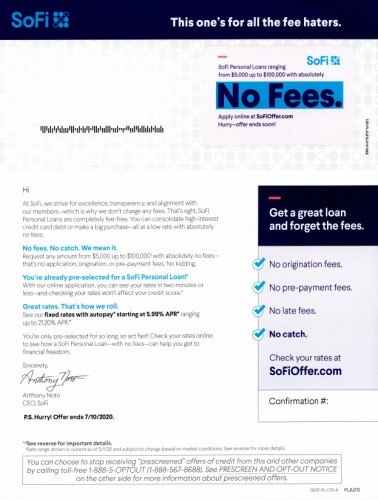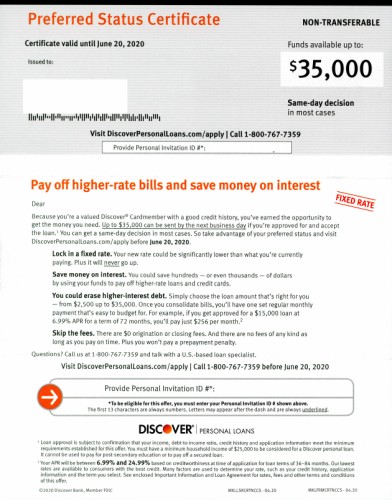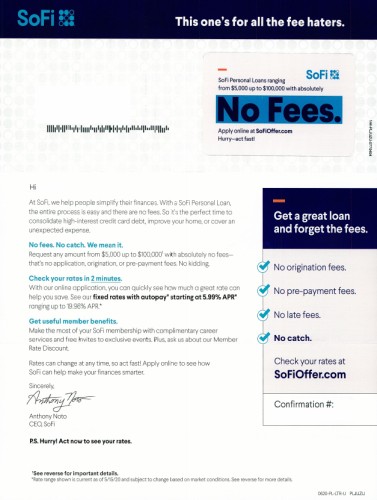5 ways to rethink assessing credit
In a time of joblessness and increased uncertainty about the economic future, lenders must get creative about how they assess and offer credit to their customers.
1- Know your competition
Mail volumes for credit cards and personal loans are at historic lows, but despite these small volumes, acquisition offers are still out there. It’s crucial to stay on top of what is in the market, and understand who products are being marketed to.
Although at much lower volumes than usual, lenders like Discover, SoFi, and OneMain are still sending millions of personal loan mail offers each month. In the credit card space, long-time leader Capital One had all but abandoned mail offers by June, leaving Discover and Wells Fargo in the top two positions for Q2.

2- Know your customers
Entering new relationships requires some leap of faith, and the same applies for banking relationships. Things are easier, however, when there is shared history.
Many financial institutions, like Discover and Capital One, lead with messages thanking customers for their loyalty. This show of appreciation from the provider can help customers feel valued and want to extend the relationship.

My Chase Loan and Citi’s Flex Loan both allow existing credit card customers to borrow a lump sum of cash against the unused portion of their credit card limit, at a fixed rate with a fixed repayment schedule. Unlike other personal loans, credit card customers have already been approved for their card’s limit, so no further credit check is required.

3- Utilize third-party tools
Financial institutions have long relied on credit bureaus to provide them with information on current customers and new prospects. As technological advances and shifts in consumer behavior have upended the traditional scoring methodology, many of those providers have altered their models to include additional information around an individual’s credit-worthiness.
FICO and Experian have led the charge towards including alternative credit metrics.

4- Follow the fintechs
One of the core missions of many fintech lenders is to provide credit to those blocked by traditional models. Leveraging data around payments, subscriptions, cashflow, and even online behavior helps these lenders identify and assess new customers.
SoFi, for example, decreased mailings significantly in April and May but rebounded strongly in June. The diverse set of products that SoFi offers, also including student loans, deposit, and investment accounts, might give them an advantage over some of their peers in cross-selling to existing customers.

Fintechs are also increasingly disrupting the credit card space. New entrants like Petal, Tomo, and Karat are looking to attract young consumers, new immigrants, and others who are shut out or fed up with their current options, and offer them products with competitive features and rates.

5- Observe value proposition in marketing
To differentiate themselves from the growing field, many of these providers are placing the emphasis on alternative credit at the forefront of their marketing efforts.
For those customers struggling financially, or actively trying to rebuild their profiles, messages like “you are more than your credit score” may resonate particularly well. Traditional lenders and fintechs alike would be smart to recognize this value in marketing, and attract a different type of customer.
Upstart has repeated the “more than my credit score” message in both Facebook and direct mail campaigns. Notably, they call out the inclusion of education and job history in addition to the numerical score.
Credit score messaging has been observed from both traditional and fintech lenders.


What we think
Consumer behavior has evolved
Traditional scoring methods are not as relevant as they once were. Younger consumers, in particular, are more debt-averse than past generations. They also carry large amounts of student debt, display a tendency to rent over owning a home, and use debit cards more frequently. Fintechs have already embraced alternative metrics to assess credit-worthiness, and traditional bureaus are also finally catching up.
Stimulus created added uncertainty
While the one-off stimulus checks and increase in unemployment benefits have helped many stay afloat, they have also created a false impression of the ability for some consumers to withstand a much longer period of downturn. Additionally, generous offers of forbearance have made it difficult for lenders to know why customers are skipping payments – because they are struggling, or just capitalizing on an opportunity.
Hesitancy creates opportunity
Many lenders are being overly cautious – drastically reducing marketing efforts and pulling certain products off the market. Others are choosing to focus on current portfolios and stockpiling reserves to cover anticipated delinquencies and charge-offs. While this conservative behavior is needed to secure the financial system, it also creates pockets of opportunity for those with more advanced capabilities to identify and target credit-worthy customers.




